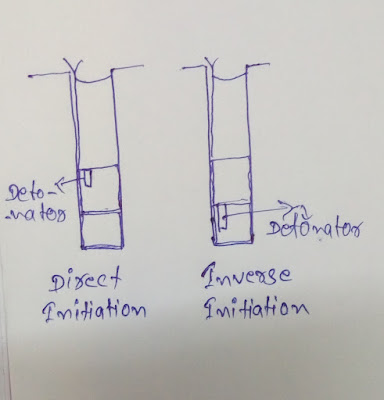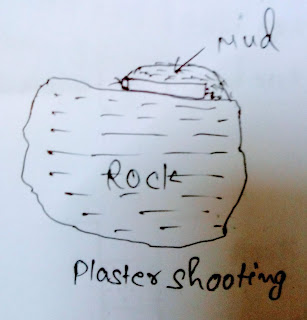Wire Ropes and it's construction
In mining industries wire ropes are widely used for different purposes. To perform different tasks, ropes having different qualities (strength, flexibility, galvanisation and other).
Before using the wire rope in mining industries it subjected to under go many tests. They are...
1. Tensile test
2. Bending Test
3. Wrapping Test
4 Torsional Test
5. Looping Test
Types of Rope according to use..
The ropes are divided in two types according to use ..
1. Standing Rope :- The ropes which is not use for running purposes..
Ex:- Guy Rope, Guide Rope etc..
2. Running Rope :- As name indicates it is use for running purposes..
Ex.:- Winding, Haulage, Craning etc..
On the basis of construction wire ropes are divided in to two types..
1. Stranded Ropes
2. Non-Stranded Ropes
Now, below you can know a details about the both types of constructions...
1.The meaning of stranded rope is, it is made-up of strands and the strands are made-up of number of concentrically twisted wire which are alike helix. They are mainly used for haulage purposes.
For using in mines the flexibility is also a important factor, so the flexibility of wire depends upon 1. Thickness of Core
2. Thickness of individual wire
3. Number of wires
In any wire ropes the wire are laid around a core. So the cores are of following types:-
1. Fibre Core
2. Steel Core
3. Independent Wire Rope Core(I.W.R.C)
Before the discussion of Non-stranded rope. It is important to about lays.
- The lays in wire ropes indicates the direction of laying of wire ropes.
There are two types of lays.
1. Right Hand lay:- In this lay wire ropes are spiral in same direction as the thread of right hand screw.
2. Left Hand lay:- This is just opposite of right hand.
Now we discuss some other lays. They are Lang's lay and ordinary lay.
1. Lang's lay:- In Lang lay, the strands in rope and wire in strand are in same direction. It causes spin. So it don't at free end.
2. Ordinary lay:- In ordinary lay, the strands in rope and wires in strand are in opposite direction.
Non-stranded wire rope
As name indicates non-strand means there is no strand. In this type of rope the wires are directly attached or messed.
Some disadvantages if Non- stranded rope:-
1. We can't lubricant it's interior directly.
2. It do not have much flexibility and also we can't spliced.
3. It's construction is much difficult.
*The use of flate rope is very less in our country. This rope is much flexible than round rope but it's is shorter. This is also a strand rope whose core having triangular cross-section.
Before using the wire rope in mining industries it subjected to under go many tests. They are...
1. Tensile test
2. Bending Test
3. Wrapping Test
4 Torsional Test
5. Looping Test
Types of Rope according to use..
The ropes are divided in two types according to use ..
1. Standing Rope :- The ropes which is not use for running purposes..
Ex:- Guy Rope, Guide Rope etc..
2. Running Rope :- As name indicates it is use for running purposes..
Ex.:- Winding, Haulage, Craning etc..
On the basis of construction wire ropes are divided in to two types..
1. Stranded Ropes
2. Non-Stranded Ropes
Now, below you can know a details about the both types of constructions...
1.The meaning of stranded rope is, it is made-up of strands and the strands are made-up of number of concentrically twisted wire which are alike helix. They are mainly used for haulage purposes.
For using in mines the flexibility is also a important factor, so the flexibility of wire depends upon 1. Thickness of Core
2. Thickness of individual wire
3. Number of wires
In any wire ropes the wire are laid around a core. So the cores are of following types:-
1. Fibre Core
2. Steel Core
3. Independent Wire Rope Core(I.W.R.C)
Before the discussion of Non-stranded rope. It is important to about lays.
- The lays in wire ropes indicates the direction of laying of wire ropes.
There are two types of lays.
1. Right Hand lay:- In this lay wire ropes are spiral in same direction as the thread of right hand screw.
2. Left Hand lay:- This is just opposite of right hand.
Now we discuss some other lays. They are Lang's lay and ordinary lay.
1. Lang's lay:- In Lang lay, the strands in rope and wire in strand are in same direction. It causes spin. So it don't at free end.
2. Ordinary lay:- In ordinary lay, the strands in rope and wires in strand are in opposite direction.
Non-stranded wire rope
As name indicates non-strand means there is no strand. In this type of rope the wires are directly attached or messed.
Some disadvantages if Non- stranded rope:-
1. We can't lubricant it's interior directly.
2. It do not have much flexibility and also we can't spliced.
3. It's construction is much difficult.
*The use of flate rope is very less in our country. This rope is much flexible than round rope but it's is shorter. This is also a strand rope whose core having triangular cross-section.


